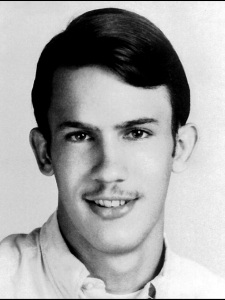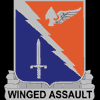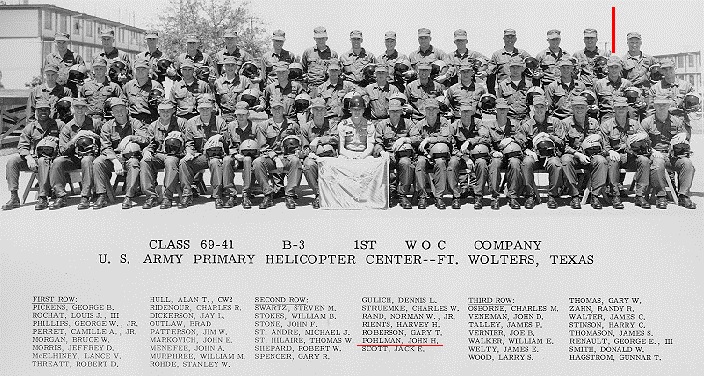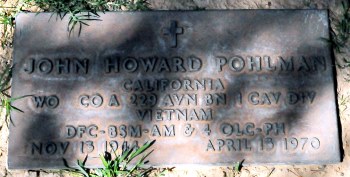|
John Howard Pohlman
Warrant Officer
A CO, 229TH ASLT HELO BN, 11TH AVN GROUP, 1ST CAV DIV, USARV Army of the United States North Edwards, California November 13, 1944 to April 15, 1970 JOHN H POHLMAN is on the Wall at Panel W11, Line 9 |
  |

|



| |
|
John Howard Pohlman was the only child of Ruthellen 'Rudy' and Howard James 'Jim' Pohlman. John graduated from High School in Edwards California in 1962 as President of his class and winner of the Bank of America and American Legion Citizenship awards. He attended the University of California at Santa Barbara where he began keeping a journal in 1964. He graduated in June 1967 at which time there was no alternative to being drafted. He did not believe in the necessity of the U.S. involvement in Vietnam, but was not an anti-war protester. John joined the Peace Corps after graduation from college, hoping the United States would value his service there more than on the battlefield. He was assigned to one of the most remote inhabited islands of the 300 island chain of Fiji. As he taught the children English, he loved the island people. However, his assignment was interrupted when he was drafted off the Island for military service. He volunteered for helicopter pilot training with an eye toward using the skill when he ended his military service as he very much intended to return to Fiji after Vietnam. John took his basic training at Fort Polk Louisiana, then Warrant Officer Candidate School, Class 69-41 B3, Fort Wolters, Texas and Second Phase, Class 69-45 at Fort Rucker, Alabama. Photo below gives you an idea of size, and names of John's classmates at Fort Wolters (69-41). 
Upon completion of training, graduation and aviator wings on 26 January 1970, and 30 days leave, John and his classmates departed for Vietnam, arriving on 3 March 1970. After 8 days of 'in-country' orientation (3 times in as many months), John and several others he knew from Class 69-45 were assigned to the 229th Assault Helicopter Battalion (AHB), 1st Cavalry Division, in Tay Ninh Province - a 'hot' Area of Operation (AO). They would be flying support missions for the busiest Infantry Brigade in the entire theater at the time. For the next few days, they tried to acclimate themselves to the unit's routine: rotating between the boredom of downtime between flights and sheer terror of flying into 'hot' landing zones or Fire Support Bases. John would spend the next month supporting such bases as Camp Gorvad, Phouc Vinh, Buttons, St. Barbara, Tay Ninh, Carolyn, Ann, Candy, Flashner, Drum, Illingworth, Cathy, Joe, Jay, Beverly, Thunder II, Westcott, Anne, Victor, Jay, Hannas, Quan Loi, Ft. Defiance, Blondin, Washington, Buell IV, Wood, Jamie, Coffman, Thien Ngon, Ft Granite, Rhor, and finally, FSB Atkinson. There were many more FSBs in the AO as the Cav, after all, was airmobile and using a technique called "Flash" fire bases. Open, stay 3 to 5 days (in most cases), and close to move to another 'flash' base. All in an effort to locate and interdict the enemy from reaching Tay Ninh and Saigon. FSB Atkinson was opened on 13 April and closed on 17 April 1970. John was killed on 15 April during the ground attack at Atkinson, having survived attacks at FSBs Jay and Illingworth where he observed the attacks from the air. FSB Atkinson would be different for WO John H Pohlman - he would be on the ground. Was the real John Pohlman a flower child of the '60's? Was he the Peace Corps volunteer answering President Kennedy's challenge by working in a developing country? Or was the real John Pohlman the combat aviator that I knew? I can't work it out for sure -- but I think all of those answers are correct. What I do know for certain is that John Pohlman was a skilled aviator who died heroically while providing battlefield illumination over a desperate struggle - enabling American ground troops to defend themselves from a murderous attack by a numerically-superior enemy force. And I know that he was the flower of our youth - the finest of a generation. . . . Please add my description of events to John's page on the Virtual Wall. I hope I've got it all right. Below is something I sent to Pohlman's room-mate after talking to my buddy, Jack McCormick late last year. Dan Tyler, Pilot229th AHB, RVN 13 April 2013 Yesterday (13 September 2012) I (Dan Tyler) spoke over the phone with a colleague from Charlie Company of the 229th - Jack McCormick -- who arrived in Vietnam a few weeks after John and I did. I thought I remembered that Jack had told me about witnessing the events at FSB Atkinson on 15 April - but I didn't remember all the details. He filled me in on some more details that I hadn't previously known. Jack is a retired Delta Airlines Captain from the Atlanta area and is very heavily involved with a group known as the Army Aviation Heritage Foundation. He arrived in Vietnam in late March, 1970 and was assigned to C/229th in early April. He was flying as co-pilot on one of his first Nighthawk missions with Warrant Officer Tony Hagan as aircraft commander. Jack remembers that they were launched from Tay Ninh when the attack on FSB Atkinson started - and that they were routed a long way up north and then west and finally back to the south to avoid all of the air activity and artillery that was in progress to help stave off the attack. They were assigned to make passes to the west of the fire support base to try to spot (using their starlight scope) the .51 calibre machine gun emplacements that were causing so much havoc for the other aircraft operating over the battle. Jack told me that an Air Force forward air controller was orbiting the base and trying to coordinate all the air support and keep them from running into each other. The FSB was situated so close to the Cambodian border that they were working in a very narrow corridor of airspace. Nighthawk operated at low level but had their lights blacked out except for the very top of their anti-collision light on the top of the tail - so that their location could be seen by the helicopter gunships that flew above and behind them for cover. Jack told me that they hadn't been able to spot any of the .51 cal positions until they came around for another north to south pass when they noticed John's flareship descending toward the firebase on fire. At that point they could see tracers from one of the .51's firing up toward John's helicopter - and they attempted to suppress the source of those tracers with their mini-gun. Tony Hagan then told Jack to switch on all their external lights in an effort to draw the fire away from the flareship that was descending on fire. It worked and Jack said he couldn't believe the amount of fire that was suddenly directed from the .51 calibre machine gun positions onto the nighthawk bird after their lights were switched on. He tried to count the tracers that whizzed past them (with four regular rounds in between each tracer) but gave up as there were too many. When they turned back north again to come back for another pass - the battleground was on Jack's side of the helicopter and he saw John Pohlman's helicopter on the ground and thought they had landed safely inside the fire support base. At that stage they were low on both fuel and ammunition and had to return to Tay Ninh. They didn't learn the outcome until later that night. Jack didn't know John personally but he remembered the event very clearly and he knew that it was the Alpha Company flareship that had gone down and its co-pilot killed. I recall hearing Jack tell me the story previously, but I didn't realize until yesterday that this was the same event in which John lost his life and was done in an effort to draw fire away from John's descending helicopter. It worked - unfortunately other events intervened for John. The excerpt below is taken from an e-mail to me dated 3 October 12 from Jim Wilson - a pilot with A/229th who was sent out to FSB Atkinson to replace the downed flareship. His room-mate (Bill Weaver) was the aircraft commander on Pohlman's aircraft that went down. I'm sending this material because the source of the information is much closer to the actual event than I was and I feel any information going on The Virtual Wall should be cross-checked for accuracy. Jim Wilson wrote:
At 2200 hours, on 15 April 1970, approximately 8 Kilometers West-Southwest of Thien Ngon Airfield, units of the 2nd Battalion, 7th Cavalry and 2nd Battalion, 19th Artillery, who were on FSB Jay on the 29th, and several of the units who had defended FSB Illingworth also supported repelling the attack by elements of 95C NVA Regiment at FSB Atkinson. The small base was named in honor of SP4 Gerald T. Atkinson, D Company, 2nd Battalion 7th Cavalry who died on March 12, 1970. An intense indirect fire attack was followed by determined ground assault. A highly coordinated infantry and artillery defense repulsed the attack by 0230 hours. The enemy was unsuccessful in his attempt to penetrate the position and 38 of the 66 NVA dead were found in the immediate area, along with numerous crew served and individual weapons. Americans paid a dear price from the assault on FSB Atkinson -- 7 killed and 25 wounded in action. The US dead were:
The official combat after action report with details here. John arrived in-country Vietnam on 3 March to begin his tour and was ultimately assigned to A Company, 229th Assault Helicopter Battalion (AHB). The day before he arrived at the battalion, CPT William Lorimer, Commanding Officer of C Company, 229th AHB was killed. Forty-five short days later, WO1 John Howard Pohlman was also killed. The 229th Assault Helicopter Battalion lost 12 men from the time CPT Lorimer arrived in Vietnam on August 11, 1969 until his death on March 10, 1970. During the period 3 March when WO Pohlman arrived in-country, and 15 April when he was killed, the 229th lost 7 men. The 229th AHB lost a total of 119 men (101 names here) during the Vietnam war. Read the preview of John's Journal, a 6-year journal concerning a young man's journey toward adulthood and maturity that allows the author to deal with the prospect of war. Includes John's own poetry and several entries from Vietnam written in the final days before his death. All proceeds of this book are providing direct support for education, health, and wellbeing of Fijians living in remote villages through the not-for-profit charitable foundation, Naqaqa Giving Foundation. At the time of his death, WO Pohlman was survived by his mother, Ruthellen "Rudy" Pohlman and his father Howard James "Jim" Pohlman (1920-2009), then living at Sunnyslope Avenue, North Edwards, California. John was buried at Joshua Memorial Park in the Court of Revery, plot 64H, Lancaster, Los Angeles County, California, 
Jim enlisted during World War II on 3 Jun 1942 for the Army Air Corps, as a Warrant Officer. Prior to war he was a mechanic, married, and had 1 year of college. He returned to obtain his teaching degree. In 1988, they moved to North Edwards. He was a retired member of the Association of California School Administrators, after a teaching and administrator career at Desert High School, Edwards Air Force Base, California. After John's death, Jim and Rudy returned to Fiji for 3 or 4 days to tell the Fijians about John's death in Vietnam. They also set up a memorial fund of $3000 for the Fijian children of Ono-i-Lua. Jim and Rudy retired to Florida where they were members of the St. Petersburg Yacht Club. When Jim passed away on April 10, 2009, his ashes were given to Rudy for final disposition. - - The Virtual Wall, September 17, 2014
|
| Contact Us | © Copyright 1997-2019 www.VirtualWall.org, Ltd ®(TM) | Last update 08/15/2019 |